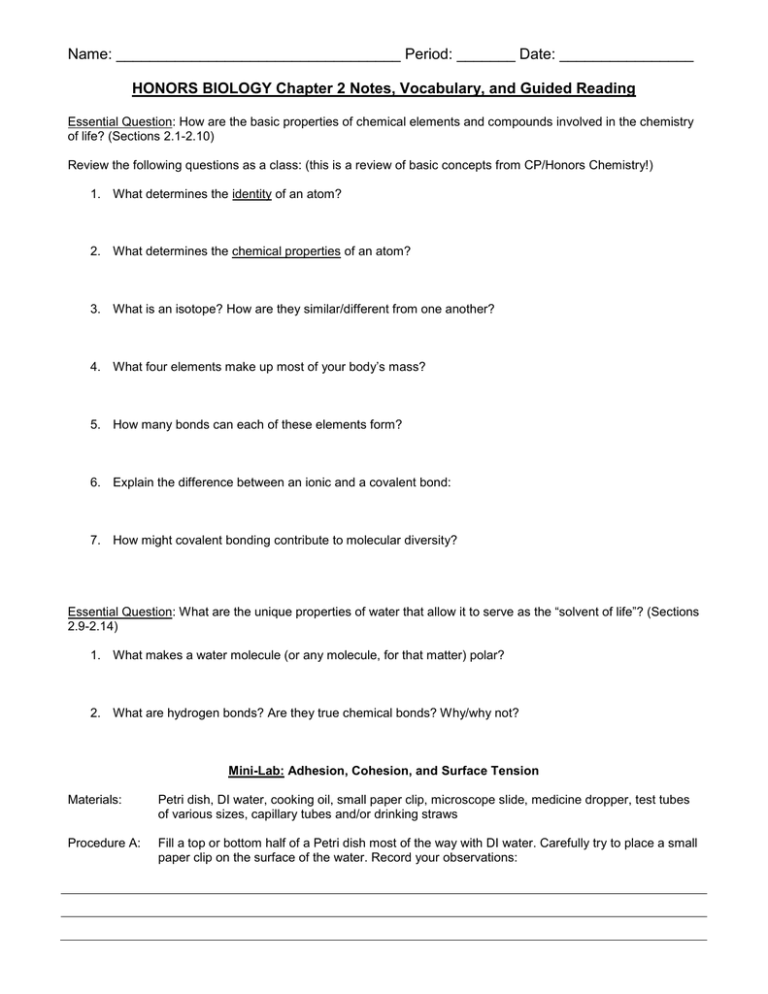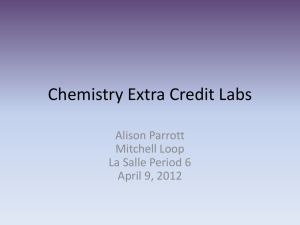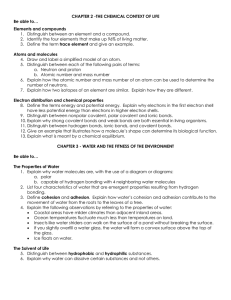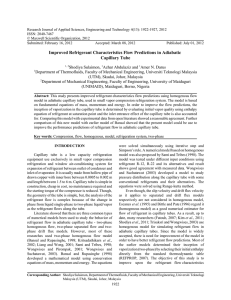Name: Period: ______ Date
advertisement

Name: __________________________________ Period: _______ Date: ________________ HONORS BIOLOGY Chapter 2 Notes, Vocabulary, and Guided Reading Essential Question: How are the basic properties of chemical elements and compounds involved in the chemistry of life? (Sections 2.1-2.10) Review the following questions as a class: (this is a review of basic concepts from CP/Honors Chemistry!) 1. What determines the identity of an atom? 2. What determines the chemical properties of an atom? 3. What is an isotope? How are they similar/different from one another? 4. What four elements make up most of your body’s mass? 5. How many bonds can each of these elements form? 6. Explain the difference between an ionic and a covalent bond: 7. How might covalent bonding contribute to molecular diversity? Essential Question: What are the unique properties of water that allow it to serve as the “solvent of life”? (Sections 2.9-2.14) 1. What makes a water molecule (or any molecule, for that matter) polar? 2. What are hydrogen bonds? Are they true chemical bonds? Why/why not? Mini-Lab: Adhesion, Cohesion, and Surface Tension Materials: Petri dish, DI water, cooking oil, small paper clip, microscope slide, medicine dropper, test tubes of various sizes, capillary tubes and/or drinking straws Procedure A: Fill a top or bottom half of a Petri dish most of the way with DI water. Carefully try to place a small paper clip on the surface of the water. Record your observations: Define surface tension and use it to explain your observations of the interactions between paper clip and the water’s surface: Procedure B: Fill a small test tube halfway with DI water. Fill another one half way with cooking oil. Observe any differences in the shape of the surface of each liquid: Procedure C: Place a small drop of water near the end microscope slide. Place a small drop of cooking oil on the same slide. Tilt the slide vertically and allow the drops to move along the surface of the slide. Observe the differences in the way the two drops behave: Procedure D: Dip a straw or capillary tube into a container of water. Observe the behavior of the water in the tube: Define adhesion and cohesion and use them to explain the behavior of water and oil in procedures B, C, and D above: 3. What makes water the “solvent of life”? 4. How does water help regulate temperature? 5. What is pH? How is life affected by changes in pH? Essential Question: How do Biologists describe a basic chemical reaction? 1. What is the basic “anatomy” of a chemical reaction? 2. What are exergonic reactions? (p.82) Give an example. 3. What are endergonic reactions? (p.82) Give an example.










